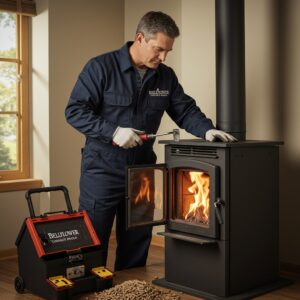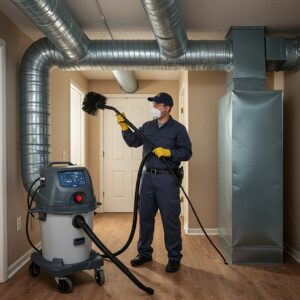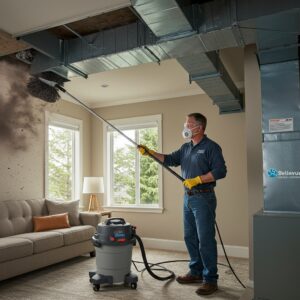
Greene County, PA is known for its rolling hills, rural charm, and—if you’ve lived here long enough—its wildly unpredictable weather. Between ice storms in the winter and pounding rains in the spring, your roof is constantly battling the elements. These shifts from season to season can gradually wear down your roofing system or cause sudden damage that needs urgent attention. That’s why staying on top of Greene County roof repair is a key part of homeownership in the region.
In this guide, we’ll walk through the major roofing challenges for each season and how to prepare for them, plus we’ll share tips on when to repair, when to replace, and when to call in a professional.
Winter: Ice Dams and Heavy Snow Loads
Winter brings more than just the holidays—it brings snow, ice, and freezing temperatures that can wreak havoc on your roof.
Common Winter Roofing Issues:
-
Ice Dams: These form when heat from your attic melts snow on the roof, which refreezes at the eaves. Water backs up behind the dam and can seep under shingles.
-
Heavy Snow Load: Excessive snow can stress your roof structure, especially on older homes.
-
Freeze/Thaw Cycles: These cause expansion and contraction that can loosen flashing and crack sealants.
Winter Roofing Tips:
-
Insulate and ventilate your attic to minimize snow melt and ice dam formation.
-
Remove excess snow with a roof rake after heavy storms.
-
Schedule an inspection before the season starts to identify weak points.
Spring: Rain, Rain, and More Rain
Spring is when roof damage from winter is most likely to show up. Leaks tend to appear as the weather warms and rainfall increases.
Common Spring Roofing Issues:
-
Hidden Winter Damage: Cracked shingles or flashing from ice buildup may start to leak.
-
Storm Damage: Thunderstorms with high winds and hail can loosen or break shingles.
-
Gutter Overflow: Melting snow and spring rain can overwhelm poorly maintained gutters.
Spring Roofing Tips:
-
Check your attic for signs of water damage or mold.
-
Clear gutters and downspouts to ensure proper drainage.
-
Examine your roof from the ground with binoculars or hire a Greene County roofing contractor to do a closer inspection.
Summer: Heat and UV Degradation
Don’t let summer sunshine fool you—heat and UV radiation can break down roofing materials over time, especially asphalt shingles.
Common Summer Roofing Issues:
-
Blistering Shingles: Caused by trapped moisture and high heat.
-
Thermal Expansion: Can create gaps at flashing and joints.
-
Humidity Damage: Without proper attic ventilation, moisture can build up and degrade roofing from the inside.
Summer Roofing Tips:
-
Check for soft spots or bubbling in shingles.
-
Ensure your attic ventilation system is functioning correctly.
-
Trim trees and branches that could fall during summer storms.
Fall: Debris and Pre-Winter Prep
Autumn is the ideal time for preventive maintenance. Falling leaves and cooling temps signal it’s time to get your roof ready for winter.
Common Fall Roofing Issues:
-
Clogged Gutters: Fallen leaves can block drainage and create water overflow.
-
Chimney Flashing Leaks: Cooler weather can cause metal flashing to contract, exposing gaps.
-
Debris Pileup: Leaves and twigs can trap moisture against your shingles.
Fall Roofing Tips:
-
Clean gutters regularly through the season.
-
Schedule a professional inspection before the first freeze.
-
Look out for roof pests (like squirrels) seeking winter shelter.
Signs Your Roof Is Failing—No Matter the Season
While seasonal issues vary, certain red flags should always catch your attention:
-
Water stains on ceilings or walls
-
Curling, cracked, or missing shingles
-
Moss or algae growth
-
Grit from shingles in gutters
-
Sagging roof lines
If you notice any of these, you may be dealing with more than just seasonal wear and tear. Getting a prompt inspection can help you figure out whether it’s time for a repair—or even a replacement.
How to Create a Year-Round Roofing Maintenance Plan
A great roof doesn’t just happen—it’s maintained. Here’s a simple plan to keep your roof healthy all year:
Quarterly Tasks:
-
Check gutters and remove any debris.
-
Visually inspect for missing shingles or damage.
-
Walk your attic (or crawl space) to check for moisture or mold.
Seasonal Tasks:
-
Schedule professional inspections in spring and fall.
-
Before major storms or heavy snow, check flashing and seals.
-
After big storms, look for signs of impact damage or leaks.
Annual Tasks:
-
Re-caulk flashing or vents as needed.
-
Have a Greene County roofing contractor inspect your attic ventilation and insulation.
-
Consider a drone inspection for hard-to-see areas if you have a complex roofline.
The Cost of Delaying Roof Repairs
It’s tempting to delay fixing a small issue, but the costs can stack up quickly. Consider the financial risks:
-
Minor shingle replacement: $200–$500
-
Water damage repairs: $2,000–$5,000
-
Mold remediation: $500–$6,000
-
Structural repairs due to rot: $10,000+
Spending a little now could save thousands later.
DIY vs. Pro: Know Your Limits
There are a few things homeowners can safely do—cleaning gutters, visually inspecting shingles from the ground, checking for attic leaks—but roofing isn’t a weekend project for most people.
Hiring professionals ensures:
-
Safety from falls and injury
-
Proper diagnosis and repairs
-
Warrantied work and insurance coverage
For large jobs like re-flashing, major leak repair, or a full replacement, always leave it to experienced roofing Greene County professionals who know the local environment and regulations. You can find trusted installation services here.
Final Thoughts: Protect Your Roof, Protect Your Home
In Greene County, your roof does a lot of heavy lifting. It shields your home through hailstorms, ice, heat, and high winds. Giving it seasonal attention and knowing when to get expert help can extend its life and preserve your property value.
Instead of waiting for something to go wrong, make roof maintenance part of your home care routine. A little vigilance each season can go a long way toward keeping your roof strong for years to come.





